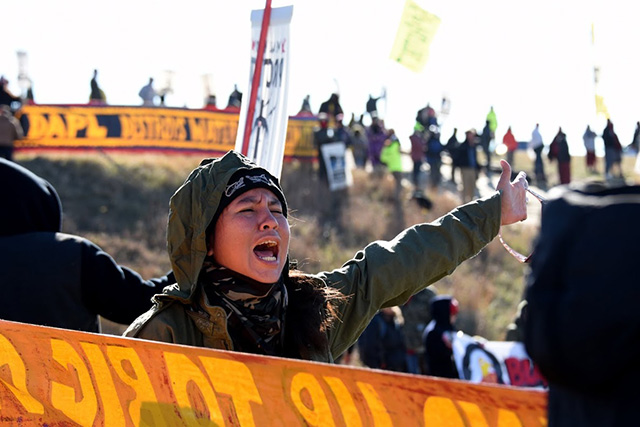
Grandfather, look what I have done to our world.
Mother Earth is on her knees…
I want to go where the others go…
I don’t have time to dance in the old way Grandfather.
Grandfather?
Grandfather please stop crying.
Grandfather, don’t you know me?
—Extracted from a poem by Charles Philip Whitedog
Having just flown in from Mexico, my first night at the campground in Standing Rock felt especially cold. Temperatures had dropped to the low 30s and strong winds shook my rented minivan until 4 in the morning. By 6:45 am, the illumination of the yet invisible sun revealed that many of the tents around me had been blown down. The tepees of course were still standing. People all around for as far as I could see were reverently standing and facing east with hats removed in spite of the nip in the air. An elder’s voice echoed out from the PA system on the hill with a traditional Lakota prayer and song. I stood similarly, waiting in anticipation of the ball of sacred fire to make its first appearance and then staring at it with wide-open eyes seeking a vision from within it and giving unrestrained thanks for the new day it promised.
By 9 am I had been informed that today there would be no direct actions to stop the forward progress of the pipe laying, but that a Veterans for Peace meeting was scheduled for 2 pm. Being a cofounder of the Northern Arizona chapter of Veterans for Peace, I was pleased to see the national organization’s peace statement written by Brian Trautman, one of my doctoral students, in support of the water protectors, and knew from my time at the Pine Ridge reservation in South Dakota that veterans can play an important role in such battles as this.
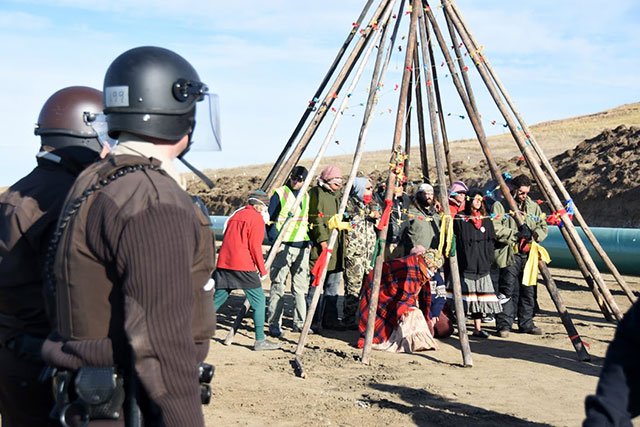 Gathered under tipi poles at the protest site in Standing Rock, a group of water protectors continue their demonstration after being told to leave by the police on October 10, 2016. (Photo: Ellen Davidson)
Gathered under tipi poles at the protest site in Standing Rock, a group of water protectors continue their demonstration after being told to leave by the police on October 10, 2016. (Photo: Ellen Davidson)
At the meeting, a Standing Rock man who had been on the scene since the group of youth ran 500 miles from to Omaha in late April to stop the pipeline, began speaking about the many treaties being broken by the Dakota Access pipeline (DAPL) and of President Obama’s useless request that the company “voluntarily” cease operations. Heads shook in disgust as he spoke, but tears flowed when he told of how the poisoned prairie dogs in the path of the pipeline led to the tragic deaths of the eagles who feed upon them and to at least seven buffalo who grazed from grasses in the poisoned dirt.
He then described having seen a high-intensity industrial light flashing across the river at night in an area where the pipeline would head toward South Dakota. He believed it was a sign that Dakota Access LLC was secretly working, and he drove for hours in an effort to prove his suspicion. Winding up on Country Road 76, he lost track of the light and there seemed to be no roads leading to where it had apparently been.
His story was important since on September 16 the US Court of Appeals ordered that Dakota Access LLC be “enjoined pending further order of the court from construction of the Dakota Access Pipeline for 20 miles on both sides of the Missouri River at Lake Oahe.” Judges, even those who might be swayed by powerful corporations, don’t like it when companies violate their orders. That night three of us veterans spent hours unsuccessfully trying to find the site of the industrial light he might have seen.
The longest discussion at the meeting had to do with our helping promote spirituality during all direct actions. Mandates for peaceful approaches have been followed remarkably consistently, but it seems that a growing number of water protectors have begun using words to ridicule or challenge the militia (including local police, police from other counties, state troopers, FBI agents and Bureau of Indian Affairs [BIA] Police) who are protecting Energy Transfer Partners, a ruthless corporation that is known for its willingness to break the law and pay fines (such as the $10 million it paid when it was found guilty of fraudulent manipulation of natural gas prices.)
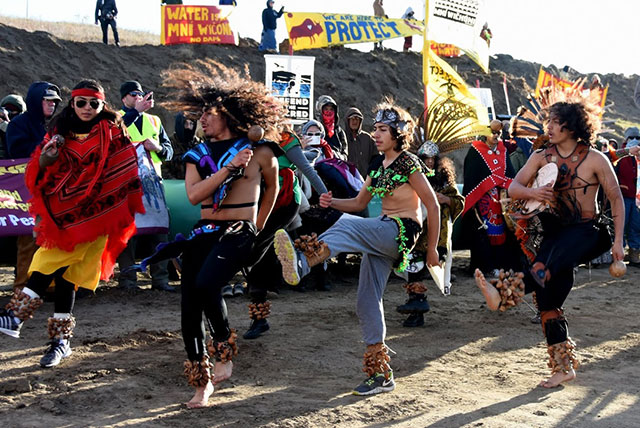 “Cousins from the South” — a group of Aztecs — dance during the demonstration against the Dakota Access pipeline in Standing Rock on October 10, 2016. (Photo: Ellen Davidson)
“Cousins from the South” — a group of Aztecs — dance during the demonstration against the Dakota Access pipeline in Standing Rock on October 10, 2016. (Photo: Ellen Davidson)
We understand the anger the water protectors feel about such things when guns have been pointed at them. However, we veterans deeply know also the importance of maintaining a high degree of respectful empathy for “our enemy” in all operations. This is especially important now that the citizens of Mandan have started claiming the “protestors” are armed and violent. The farmers complained that combine drivers were refusing to come to work because of the “dangerous Indians.”
Right before the Veterans for Peace meeting convened, Daryl Lies, the director of the North Dakota Farm Bureau, had just demanded that the governor stop the protest because of how unsafe local communities were feeling and how much money it was costing the farmers. No details or evidence of such danger had been offered, and some of us guessed that Dakota Access LLC security firms were practicing psychological warfare tactics, as they had done during the BP spill, by creating such enmity. In any case we had to do everything to practice spiritual resistance of the highest order.
The next morning around 5 am a number of us gathered for an inipi ceremony. In addition to taking part in collective prayers for the safety and success of the day’s planned action, I also asked the spiritual energies how I might be useful during my relatively short stay before I had to return to Mexico to continue my effort to create the first marine no-take zone on the Costalegre so as to recover our fisheries.
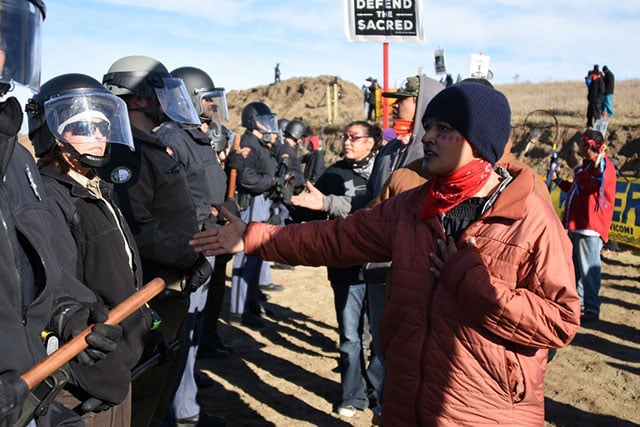 Members of the Indigenous Youth Council extend their hands to an unmoving line of police officers during the demonstration against the Dakota Access pipeline in Standing Rock on October 10, 2016. (Photo: Ellen Davidson)
Members of the Indigenous Youth Council extend their hands to an unmoving line of police officers during the demonstration against the Dakota Access pipeline in Standing Rock on October 10, 2016. (Photo: Ellen Davidson)
Suddenly the spirits “told” me to search for the area where the pipeline might have illegally been laid. Immediately after breakfast I took off in search of Country Road 76. It took most of the day, but I found the likely place. It was well hidden behind an alfalfa field where it could not be seen or accessed by car. Miles of pipeline had been dug in, with fresh mounds of dirt still standing along with left-behind equipment. I took many photos, including one of an unburied pipe with the pressure testing date on it that might be used to make our case. Hoping to catch workers in the act of installing the pipeline, I scheduled a local airplane charter service for an hour’s flight over the area on Monday, October 10, the national holiday that celebrates the beginning of ongoing genocide and cultural genocide against Indigenous peoples of the Americas.
The next day I participated in an action by joining at least 60 cars in a slow drive along the gravel county roads. Before we left I offered a prayer and reminded all of the need for our compassion for the police. Dakota Access LLC helicopters followed us as we drove along the country roads as a diversion while a smaller group went to stop machinery elsewhere. After two hours, we came upon a roadblock. Local police, state troopers and BIA police were lined up armed and in riot gear across the road, along with an armored truck equipped with a long-range acoustic device.
They blocked the entire road and would not let us continue. With my hands up, I told the officers that I had also been a uniformed officer in the Marines and had empathy with the difficult choices they were making. I appealed to their higher selves as respectfully as I could, keeping in mind the massive peaceful disobedience that brought down Slobodan Milošević when protestors appealed to his guards and they switched sides. No one switched sides that day, but perhaps some seeds were planted.
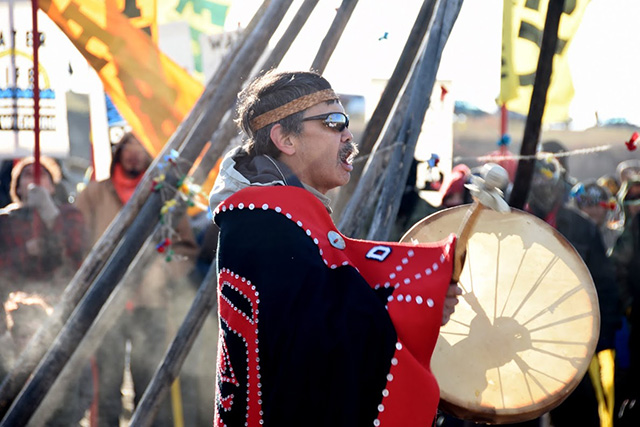 An Indigenous drummer and singer takes part in a prayer ceremony at the Dakota Access pipeline on October 10, 2016. (Photo: Ellen Davidson)
An Indigenous drummer and singer takes part in a prayer ceremony at the Dakota Access pipeline on October 10, 2016. (Photo: Ellen Davidson)
Then, on October 9, the US Court of Appeals ordered that its administrative injunction of September 16 be “dissolved.” Many are still amazed that the decision came so quickly after the October 5 hearing resulted in the three judges being unable to decide. Hopeful rumors circulated that it would be months before a final decision was made. Yet, on October 9 they suddenly decided that Standing Rock had not carried its “burden of persuasion” to show how the pipeline continuance impacts the public interest. Had the charter company told a Dakota Access LLC worker? Did a spy get wind of our plan for the air reconnaissance and put the pressure on the court?
In any case, I have told here but one of many stories like those being told around the campfires of more than 300 First Nations and their supporters from around the world. The stories are important, whether from Neil Young who tells of his support for the Indigenous mobilization against DAPL in a song or a woman suffering post-traumatic stress disorder from her boarding school experience who has committed her life to taking a stand here in Standing Rock. Equally important is your story as it unfolds with your commitment to doing everything you can to get friends, family, banks and employers who invest in Energy Transfer Partners or its subsidiaries to divest immediately, as Bill McKibben and Rebecca Adamson advocate.
Bringing attention to the financial risks relating to all the consequences of transporting oil may be the most effective strategy now. The corporation claims in a September 14 court filing that Dakota Access LLC would lose $1.4 billion in its first year of delays as a result of the Standing Rock protests. Steamrolling its agenda with such claims to the Army Corps of Engineers, this document emphasizes such high costs are due to the “many thousands of unlawful protestors.” If investors understood such resistance will be a constant cost of oil transfer operations, in addition to likely costs of cleaning up leaks (and not mentioning the serious costs of climate change from the additional oil), we could force a change to alternative energy almost overnight.
To be effective with any strategy, truth seeking must also be a high priority. The courage to challenge and subvert cultural and educational hegemony is contagious once teachers understand how to do so. (See “Teaching Truly.”) We must also better understand the urgency of the problem facing us if we extract more oil from Mother Earth. As pioneering critical communications professor Bruce Johansen writes, we must understand “thermal inertia” and how greenhouse-gas emissions become heat, taking about 50 years in the air and 150 years in the oceans. Thus, if the climate of today reflects emissions from the 1960s, it is vital that we finally heed ancient wisdom’s call to consider the seventh generation in all decisions.
 Police handcuff the last two water protectors remaining amid the tipi poles at Standing Rock on October 10, 2016. (Photo: Ellen Davidson)
Police handcuff the last two water protectors remaining amid the tipi poles at Standing Rock on October 10, 2016. (Photo: Ellen Davidson)
Ultimately no informed strategies alone will save us. We must understand that our dominant worldview is not sustainable as I write in Point of Departure: Returning to Our More Authentic Worldview for Education and Survival (with all proceeds going to Standing Rock). We must seriously reconsider unconscious beliefs that have guided us into a human-centered and materialistic illusion of reality during the previous 1 percent of human history, while learning to re-embrace our original Indigenous understandings of our place in the natural order. For those who wish to listen to a variety of ways to do this, the presentations of Indigenous scholars and spiritual leaders this September at the University of Notre Dame’s “Indigenous Wisdom for Sustainability” conference are now available for viewing.
Even if it is too late to prevent the calamity that lies ahead, such a change in worldview can help us and future generations with rebuilding with healthier, more balanced perspectives in mind.
In the meantime we are facing a profound turning point in Standing Rock Indigenous territory. Indigenous peoples are on the front lines of environmental protection around the world, but fate has brought special attention to what is happening here in North Dakota. By assisting the courageous people here who are taking a do-or-die stand for future generations and for the Missouri River that is not a “natural resource” but a relative, it is the collective you who can now truly tip the scales in favor of future generations.
Mitakuye Oyasin. We are all related.
Join us in defending the truth before it’s too late
The future of independent journalism is uncertain, and the consequences of losing it are too grave to ignore. To ensure Truthout remains safe, strong, and free, we need to raise $22,000 by the end of today. Every dollar raised goes directly toward the costs of producing news you can trust.
Please give what you can — because by supporting us with a tax-deductible donation, you’re not just preserving a source of news, you’re helping to safeguard what’s left of our democracy.